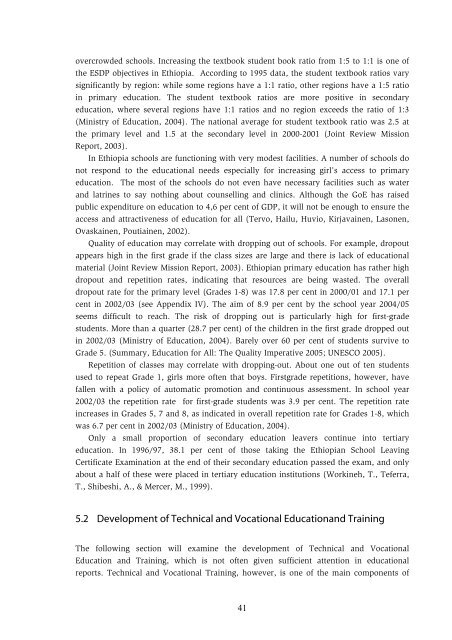Education and Training in Ethiopia An Evaluation of Approaching EFA Goals
Education and Training in Ethiopia - Koulutuksen tutkimuslaitos
Education and Training in Ethiopia - Koulutuksen tutkimuslaitos
- No tags were found...
You also want an ePaper? Increase the reach of your titles
YUMPU automatically turns print PDFs into web optimized ePapers that Google loves.
overcrowded schools. Increas<strong>in</strong>g the textbook student book ratio from 1:5 to 1:1 is one <strong>of</strong>the ESDP objectives <strong>in</strong> <strong>Ethiopia</strong>. Accord<strong>in</strong>g to 1995 data, the student textbook ratios varysignificantly by region: while some regions have a 1:1 ratio, other regions have a 1:5 ratio<strong>in</strong> primary education. The student textbook ratios are more positive <strong>in</strong> secondaryeducation, where several regions have 1:1 ratios <strong>and</strong> no region exceeds the ratio <strong>of</strong> 1:3(M<strong>in</strong>istry <strong>of</strong> <strong>Education</strong>, 2004). The national average for student textbook ratio was 2.5 atthe primary level <strong>and</strong> 1.5 at the secondary level <strong>in</strong> 2000-2001 (Jo<strong>in</strong>t Review MissionReport, 2003).In <strong>Ethiopia</strong> schools are function<strong>in</strong>g with very modest facilities. A number <strong>of</strong> schools donot respond to the educational needs especially for <strong>in</strong>creas<strong>in</strong>g girl’s access to primaryeducation. The most <strong>of</strong> the schools do not even have necessary facilities such as water<strong>and</strong> latr<strong>in</strong>es to say noth<strong>in</strong>g about counsell<strong>in</strong>g <strong>and</strong> cl<strong>in</strong>ics. Although the GoE has raisedpublic expenditure on education to 4,6 per cent <strong>of</strong> GDP, it will not be enough to ensure theaccess <strong>and</strong> attractiveness <strong>of</strong> education for all (Tervo, Hailu, Huvio, Kirjava<strong>in</strong>en, Lasonen,Ovaska<strong>in</strong>en, Poutia<strong>in</strong>en, 2002).Quality <strong>of</strong> education may correlate with dropp<strong>in</strong>g out <strong>of</strong> schools. For example, dropoutappears high <strong>in</strong> the first grade if the class sizes are large <strong>and</strong> there is lack <strong>of</strong> educationalmaterial (Jo<strong>in</strong>t Review Mission Report, 2003). <strong>Ethiopia</strong>n primary education has rather highdropout <strong>and</strong> repetition rates, <strong>in</strong>dicat<strong>in</strong>g that resources are be<strong>in</strong>g wasted. The overalldropout rate for the primary level (Grades 1-8) was 17.8 per cent <strong>in</strong> 2000/01 <strong>and</strong> 17.1 percent <strong>in</strong> 2002/03 (see Appendix IV). The aim <strong>of</strong> 8.9 per cent by the school year 2004/05seems difficult to reach. The risk <strong>of</strong> dropp<strong>in</strong>g out is particularly high for first-gradestudents. More than a quarter (28.7 per cent) <strong>of</strong> the children <strong>in</strong> the first grade dropped out<strong>in</strong> 2002/03 (M<strong>in</strong>istry <strong>of</strong> <strong>Education</strong>, 2004). Barely over 60 per cent <strong>of</strong> students survive toGrade 5. (Summary, <strong>Education</strong> for All: The Quality Imperative 2005; UNESCO 2005).Repetition <strong>of</strong> classes may correlate with dropp<strong>in</strong>g-out. About one out <strong>of</strong> ten studentsused to repeat Grade 1, girls more <strong>of</strong>ten that boys. Firstgrade repetitions, however, havefallen with a policy <strong>of</strong> automatic promotion <strong>and</strong> cont<strong>in</strong>uous assessment. In school year2002/03 the repetition rate for first-grade students was 3.9 per cent. The repetition rate<strong>in</strong>creases <strong>in</strong> Grades 5, 7 <strong>and</strong> 8, as <strong>in</strong>dicated <strong>in</strong> overall repetition rate for Grades 1-8, whichwas 6.7 per cent <strong>in</strong> 2002/03 (M<strong>in</strong>istry <strong>of</strong> <strong>Education</strong>, 2004).Only a small proportion <strong>of</strong> secondary education leavers cont<strong>in</strong>ue <strong>in</strong>to tertiaryeducation. In 1996/97, 38.1 per cent <strong>of</strong> those tak<strong>in</strong>g the <strong>Ethiopia</strong>n School Leav<strong>in</strong>gCertificate Exam<strong>in</strong>ation at the end <strong>of</strong> their secondary education passed the exam, <strong>and</strong> onlyabout a half <strong>of</strong> these were placed <strong>in</strong> tertiary education <strong>in</strong>stitutions (Work<strong>in</strong>eh, T., Teferra,T., Shibeshi, A., & Mercer, M., 1999).5.2 Development <strong>of</strong> Technical <strong>and</strong> Vocational <strong>Education</strong><strong>and</strong> <strong>Tra<strong>in</strong><strong>in</strong>g</strong>The follow<strong>in</strong>g section will exam<strong>in</strong>e the development <strong>of</strong> Technical <strong>and</strong> Vocational<strong>Education</strong> <strong>and</strong> <strong>Tra<strong>in</strong><strong>in</strong>g</strong>, which is not <strong>of</strong>ten given sufficient attention <strong>in</strong> educationalreports. Technical <strong>and</strong> Vocational <strong>Tra<strong>in</strong><strong>in</strong>g</strong>, however, is one <strong>of</strong> the ma<strong>in</strong> components <strong>of</strong>41




![to read the full report [pdf, Amharic] - Ethiopian Review](https://img.yumpu.com/52737829/1/190x245/to-read-the-full-report-pdf-amharic-ethiopian-review.jpg?quality=85)











